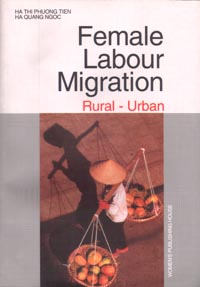
|
Female Labour Migration: Rural-Urban Women's Publishing House Hanoi, 2001. pp. 264 review by Jocelyn Grace |
|
Intersections: Gender, History and Culture in the Asian Context
Issue 8, October 2002 doi: 10.25911/SSM0-7J55 |

|
Female Labour Migration: Rural-Urban Women's Publishing House Hanoi, 2001. pp. 264 review by Jocelyn Grace |
|
Since 1986 when the doi moi [renovation] period began, spontaneous rural-to-urban migration in Viet Nam has become a major social and economic phenomenon.[1] With the transition to a market-oriented economy, and the de-collectivisation of communes, has come the commodification of labour. While there has been general economic growth in Viet Nam during this period, the diversification of sources of income in rural areas has been minimal, unlike the experience of neighbouring China. At the same time, the rapid growth of private enterprises in urban areas has created an increasing demand for labour in both the formal and informal economy. Between 1996 and 2001, the number of recorded rural migrants in Ha Noi was 156,344, and 500,000 for Ho Chi Minh City, however it is widely acknowledged that the real figures are much higher.[2] Ho Chi Minh City also experiences a massive seasonal influx of people to its outskirts when the Mekong River floods. Regional cities such as Da Nang, Ba Rai-Vung Tau and Can Tho are also destinations for rural migrants. Between forty and forty-five percent of migrants in the cities of Ha Noi and Ho Chi Minh City are female.[3] Most studies of migration in Viet Nam to date have focused on organised forms of migration, and most information on spontaneous rural migrants is of a purely quantitative nature and has been derived from population censuses.[4] Between 1990 and 2000 Dr Ha Thi Phuong Tien of the Centre for Family and Women's Studies, Ha Noi, and Dr Ha Quang Ngoc of the Institute on State Organizational Sciences, Ha Noi, carried out a qualitative study of spontaneous female labour migration in three cities—Ha Noi, Ho Chi Minh City and Da Nang. Their purpose was to investigate the reasons why women migrate to cities, their employment and living conditions in cities, the effect of their departure and arrival has on villages and cities respectively, and public opinion about spontaneous female labour migrants. They conducted in-depth interviews and group discussions with both male and female migrants involved in five types of work—porters; domestic and restaurant/bar workers; vending, collecting and scavenging; workers in textile, garment or other manufacturing enterprises; and those in the construction industry. They also conducted research in three communes from which many of the people who had migrated to these three cities had come. This book is the result of that research. In the foreword the authors make clear why there is an urgent need to investigate female migrant workers in urban areas when they write:
This is a valuable study, and the authors have provided a wealth of information and an incisive analysis of the factors which drive the wave of rural-urban migration in Viet Nam, and its social consequences. It is a shame that they did not have the benefit of the services of a professional interpreter, as the authors' meanings are often difficult to grasp. Given the importance of this research and the interest of its findings, the publishing of a revised English language edition would be justified. Endnotes [1] Spontaneous as opposed to organised, i.e. state planned and approved. [2] Ha Thi Phuong Tien and Ha Quang Ngoc, Female Labour Migration: Rural-Urban, Women's Publishing House Ha Noi, 2001. [3] Ibid. [4] Ibid. [5] Ibid, p.19. 
|
|
This paper was originally published in Intersections: Gender, History and Culture in the Asian Context, with the assistance of Murdoch University.
This page has been optimised for 800x600 and is best viewed in either Netscape 2 or above, or Explorer 2 or above. |
From February 2008, this paper has been republished in Intersections: Gender and Sexuality in Asia and the Pacific from the following URL:
intersections.anu.edu.au/issue8/grace_review2.html.
HTML last modified: 18 March 2008 1037 by Carolyn Brewer. © Copyright |